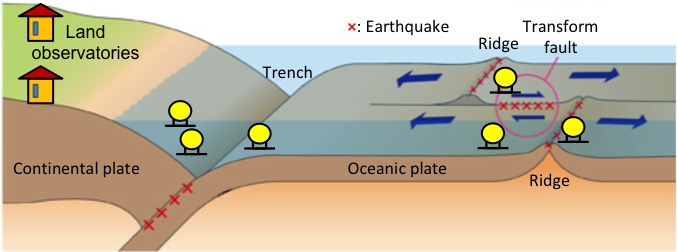Imagine a tremor, not on the surface, but deep within the Earth, miles below the ocean floor. This isn’t just a shudder, but a powerful earthquake that releases energy from a hidden world. These are deep-focus earthquakes, and their existence reveals a fascinating story about the intricate workings of our planet. But what connects these subterranean tremors to the ocean floor above? The answer lies in a dynamic feature of the ocean floor – subduction zones.

Image: www.eri.u-tokyo.ac.jp
Subduction zones, where one tectonic plate dives beneath another, are the planet’s earthquake factories. These zones are not merely places where tectonic plates collide, but complex systems where molten rock, immense pressure, and the relentless movement of Earth’s crust come together to generate both surface and deep-focus earthquakes. Understanding the relationship between these earthquakes and subduction zones provides invaluable insight into the Earth’s structure and its dynamic processes.
Delving into the Depths: Understanding Deep-Focus Earthquakes
The Unseen World of Deep-Focus Earthquakes
Unlike their shallow-focus counterparts, which generate tremors near the Earth’s surface, deep-focus earthquakes originate at depths greater than 70 kilometers (43 miles), reaching down to approximately 700 kilometers (435 miles). This implies that these events are not merely caused by the brittle fracturing of the Earth’s crust, but by a different, more complex mechanism.
The Defining Characteristics of Deep-Focus Earthquakes
Deep-focus earthquakes exhibit distinct characteristics that set them apart:
- Location: Almost exclusively confined to subduction zones, the areas where tectonic plates collide and one slides beneath the other.
- Depth: These earthquakes occur at depths far greater than shallow-focus earthquakes, ranging from 70 to 700 kilometers below the surface.
- Magnitude: Although capable of significant magnitudes, deep-focus earthquakes are generally less destructive than shallow-focus events due to their greater distance from the surface.
- Frequency: Deep-focus earthquakes are less frequent than their shallower counterparts, but their occurrence in specific locations provides crucial information about the Earth’s interior.

Image: sawyer-blogchapman.blogspot.com
The Subduction Zone Connection: A Complex Relationship
The Role of Subduction Zones
Subduction zones, the boundaries between tectonic plates, are dynamic environments characterized by intense geological activity. The descending plate, known as the “slab,” carries a portion of the Earth’s crust and upper mantle, dragging it down into the planet’s interior. This descent isn’t smooth; the slab undergoes transformation.
The Transformation of the Slab
As the slab plunges deeper, it encounters immense pressure and heat. This environment triggers significant changes in the slab’s material:
- Mineral Transformations: The rock within the slab undergoes phase transformations, as minerals rearrange themselves under pressure and heat. These transformations release heat and change the rock’s density.
- Dehydration: The slab’s minerals release water molecules, which rise into the overlying mantle. This influx of water lowers the melting point of the surrounding rock, contributing to the creation of magma.
The Birth of Deep-Focus Earthquakes
Deep-focus earthquakes are believed to be caused by these transformations within the subducting slab. As the slab descends, its minerals undergo phase transitions, changing its density and creating stress. This stress can eventually lead to sudden ruptures within the slab, releasing energy as seismic waves and triggering a deep-focus earthquake.
Unraveling the Mystery: Studying Deep-Focus Earthquakes
The Benefits of Studying Deep-Focus Earthquakes
Deep-focus earthquakes, despite their distant origin, offer a unique window into the Earth’s interior. Studying their characteristics and patterns provides valuable insights into:
- Earth Structure: The distribution and depth of deep-focus earthquakes help map the boundaries between the Earth’s crust, mantle, and core.
- Plate Tectonics: The location and occurrence of deep-focus earthquakes within subduction zones contribute to our understanding of plate movements and the processes driving these movements.
- Earth’s Interior: The minerals and pressure conditions at these depths provide insights into the composition and behavior of the Earth’s deep interior.
The Challenges of Studying Deep-Focus Earthquakes
Studying deep-focus earthquakes presents significant challenges:
- Deep Origin: Their deep location makes them difficult to study directly. Traditional seismic monitoring stations are mainly designed to detect surface-level tremors.
- Limited Data: Due to their low frequency and depth, fewer seismic records and data are available for deep-focus earthquakes compared to shallow-focus ones.
Emerging Technologies: New Perspectives
Technological advancements are bridging the gap, providing new ways to study deep-focus earthquakes:
- Advanced Seismic Networks: Global seismic networks are expanding, providing more data points to analyze deep-focus earthquakes and their patterns.
- Computational Modeling: Computer simulations and modeling are helping scientists understand the processes occurring within the Earth’s interior, particularly in subduction zones.
- Satellite Technology: Satellites equipped with advanced sensors can detect subtle ground motions associated with deep-focus earthquakes, providing data from a broader perspective.
Deep-Focus Earthquakes Are Associated With What Prominent Ocean-Floor Feature
The Future of Deep-Focus Earthquake Research
Deep-focus earthquakes remain a subject of ongoing research and fascination. As we continue to explore and understand these events, we gain deeper knowledge about the complex processes within our planet. By studying deep-focus earthquakes, we unlock the mysteries of the Earth’s interior, contributing to a more comprehensive understanding of our planet.
This in-depth journey into the world of deep-focus earthquakes has highlighted the profound link between these events and the dynamic realm of subduction zones. The intricate dance of tectonic plates, the transformations within the descending slab, and the fascinating interplay of pressure, heat, and minerals all contribute to the occurrence of these tremors in the Earth’s deepest reaches. While studying deep-focus earthquakes continues to face challenges, advanced technologies and dedicated research are paving the way for a deeper understanding of these intriguing events.
As we peer into the Earth’s depths, we gain not only scientific understanding but also a sense of awe for the intricate and powerful forces shaping our planet. So, the next time you feel a tremor, consider that it could be a message from the Earth’s depths, a reminder of the ongoing geological activity that shapes our world.





